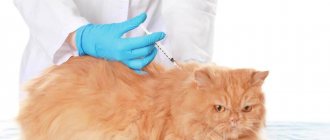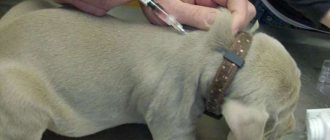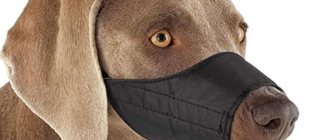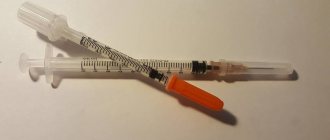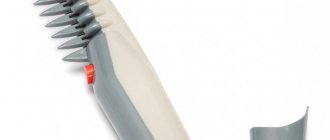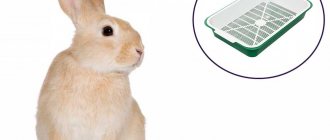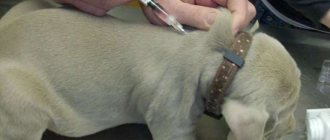Treatment of pets is usually entrusted to experienced veterinarians, since in the clinic a specialist will select the exact dosage of a particular drug and carry out the procedure according to all the rules. But is this approach advisable if the therapy involves several injections? In this case, it is wiser to carry out treatment at home, but only on condition that you know exactly how to inject a dog in the withers.
Injection tool
Depending on the dose of the drug, its properties, as well as the size of the animal, a syringe of a certain volume is selected. Often a 2 and 5 ml instrument is used. In this case, you should carefully draw up the medicine, paying attention not only to the numbers located on the scale, but also to the divisions between them.
Before injecting your dog subcutaneously at the withers, you should choose the right tool. For representatives of small breeds, it is better to administer the drug with a syringe, the volume of which is 2 ml. Some people choose insulin syringes. They are more preferable because they have a thin needle, which causes minimal discomfort when injected. This option is not suitable for large breed animals, since they have rough skin, and therefore a thin needle can bend or simply break. But if the drug is viscous, then in any case the injection should be done with a 5 ml syringe: its needle will allow the solution to penetrate the skin much faster.
Preparation for the procedure
The effectiveness of the procedure largely depends on preparation. It includes choosing a medication, calculating the dosage, purchasing tools, finding a comfortable place and calming the dog.
Selection and dosage of the drug, its preparation
The drug and its dosage are selected by the veterinarian based on the tests of the four-legged patient. Medicines intended for other types of injections can cause allergies, burns and even tissue death.
Please note that large doses are administered several times to different areas of the scruff of the neck. This reduces the likelihood of bruising and irritation.
Recommendations for preparing the drug are also provided by the doctor, but you can also read them in the instructions for use. Some substances require shaking, others require mixing.
If the medicine is stored in the refrigerator, it is necessary to warm it up to 37 ° C, since the administration of cold liquid is very painful. The final temperature should be no higher than this mark, the minimum acceptable temperature being room temperature. If you have time, just leave the bottle on the table, and if not, warm it in your hands or warm (not hot) water.
Weighing the animal
The weight of the animal affects the dosage. If you are not sure about this parameter, weigh your pet so as not to inject him more or less than the recommended amount.
Buying a syringe and needle
Here you should also rely on medical recommendations. The size of the syringe and needle is selected based on the following factors:
- Animal size. The insulin type is suitable for small breeds, and at least 3 ml in volume for large breeds. Special attention should be paid to thick-skinned quadrupeds. Thin needles are not suitable for them, as they very often break even at the moment of insertion.
- Pet's age. Puppies are injected only with insulin syringes, regardless of their breed.
- Amount of drug administered. Despite the painlessness, the procedure is still unpleasant from a moral point of view. The sooner it ends, the better. For this reason, large dosages are administered in one go with a 5 ml syringe. It comes with a fairly thick needle, but it can be replaced with a thinner one.
- If your pet is very active and fidgety, it is better to purchase a butterfly needle or an IV needle. The wire on the needle will protect it from jumping out even when the dog is too restless.
- Features of the medicinal substance. Oily solutions are not suitable for insulin varieties. They quickly clog their thin needles, so in this case it is safer to choose larger options from 3 ml.
Another important point is the presence of rubber on the piston. It slows down the insertion process, reducing the risk of pain.
Preparing the place
Large animals are placed directly on the floor in a sitting position or placed on their side with their paws extended. It is difficult to reach the scruff of small pets in this position, so they are placed on a flat, non-slip hill.
To prevent bites, use a muzzle. If your pet weighs no more than 10 kg, purchase a retainer bag. She leaves only the paws and head free, greatly facilitating the procedure. For puppies and toy dogs, this bag can be replaced by a cocoon made of thick fabric.
Psychological state of the pet
Avoid coercion by using force and yelling. Active suppression of a resisting pet is fraught with retaliatory aggression and the formation of a strong fear of the procedure in the future.
During manipulations, be sure to talk to your pet in a calm and confident voice. Dogs are unusually smart animals; they often agree to endure for the sake of their owner.
If you have to work with an incorrigible coward, enlist the support of one more person. Otherwise, attempts to escape may result in the needle breaking off and getting stuck.
Rules of asepsis and antisepsis
The dog's skin does not require treatment before administering the medicine: it is not wiped with an antiseptic, since the natural lubricant has antimicrobial properties, and the hair is not shaved off. But at the same time, the skin must be clean and without serious damage.
In some cases, veterinarians still recommend antiseptic treatment. In these situations, it is necessary to clarify what exactly to use for this purpose. This is due to the fact that alcohol, which we usually use for disinfection, is not suitable for animal skin. As a last resort, when it is not possible to consult with a specialist, you can wipe the injection site with Betadine.
To prevent infection from entering the wound when you give two injections from one syringe, you must use replacement needles. They, like the syringe itself, must be new.
Algorithm
Most drugs for animals are injected into the withers. This is the simplest manipulation that every owner should learn to do.
Procedure:
Wash the hands.- Turn the ampoule upside down and shake.
- Break it at its thinnest point.
- Use a syringe to draw out the required amount of medicine.
- Release the air from the syringe by pressing the plunger until a drop of liquid appears at the tip of the needle.
- Using two fingers, pull back the skin on the dog’s withers and remove the hair.
- Insert the needle under the skin at an angle of 45 ᵒ, carefully, slowly and without deepening it beyond the tip.
- Inject the medicine under the skin.
- Quickly remove the needle, holding the skin fold.
There is no need to disinfect the injection site before and after: dogs have a special protective layer on their skin. It is prohibited to touch the needle with your hands before administering the medicine.
Medicine for injection: how not to harm your pet
Medicine for injection should be stored in a closed ampoule. If its contents are intended for two doses, then it is necessary to immediately distribute the medicine into separate syringes. The second dose is stored in the refrigerator (if allowed by the manufacturer, which is necessarily indicated in the instructions), covering the needle with a cap. You cannot put all the medicine into one syringe and inject half the dose: the dog may twitch, causing you to inject more medicine than required.
Remember that not every drug can be stored for a long time. In most cases, the shelf life is limited to five days, but if the medicine is based on live bacteria, then its shelf life will be no more than 72 hours.
In situations where there is no accurate information about the storage rules, it is more advisable to dispose of the remains and open a new ampoule each subsequent time. Otherwise, the drug may deteriorate, and in the best case, you will inject the animal with a solution that has already lost its medicinal properties, or in the worst case, a toxic substance.
How to understand that a dog needs to be given an injection at the withers?
The treatment procedure is determined by the veterinarian. If it is necessary to administer drugs for a long time during the period of illness, it is recommended to carry out all manipulations at home. Familiar surroundings significantly reduce stress levels, facilitating recovery.
Situations of emergency administration (painful childbirth, injury) are also possible at a remote location from the veterinary clinic, when you are absolutely sure of the safety of the medicine used. To be on the safe side, you can contact your doctor by phone and get detailed advice from him.
Why exactly the withers?
The withers, or scruff of the neck, is an insensitive area with loose hypodermis, that is, the lower layer of the skin. If you follow the basic recommendations, the procedure is completely painless, and the injected substance is quickly absorbed into the blood and spread throughout the body within 30 minutes.
What other injections are there?
In addition to subcutaneous injections, there are other types of injections. These include:
- intramuscular;
- intravenous;
- intra-articular;
- intraosseous.
The last 2 types are carried out only by a veterinarian. Intravenous can be done independently if there is a special catheter in the vein installed in the veterinary clinic. The intramuscular one has the fewest nuances, but due to the high probability of touching the sciatic nerve, it requires more skill and rarely goes away painlessly.
Rules for the use of medicines
A single dose of the medicine should not exceed the recommended maximum - 90 ml per 1 kg of weight. In addition, only one drug can be drawn into one syringe. This is due to the fact that many drugs are simply incompatible, and therefore, by mixing them, you risk causing irreparable harm to your pet’s health.
And do not forget to warm up the syringe with the medicine in the palm of your hand before injection or first lower it into a container of warm water.
How to choose the right syringe
In fact, the difficulty arises when choosing a needle, not the syringe itself. With its size, everything is elementary - it depends on the volume (ml) of the administered drug. The choice of needle should depend on the size of the dog, the method of administration, and the consistency of the medication.
For example, a needle from an insulin syringe is better suited for small breed dogs. If you need to inject a larger volume, simply move the needle into a larger syringe.
For intradermal injections, a short thin needle is used; for subcutaneous and intramuscular injections, longer needles are used.
It is worth considering that the suspension, as well as oil-based medications, will be difficult to administer through a thin needle due to its rather dense consistency. They require a needle with a large diameter. These medications must be administered slowly.
How to give a subcutaneous injection?
- Before injecting your dog at the withers, prepare the medicine for injection. Make sure you take the right drug.
- Lightly file the ampoule in the marked area and break it, after covering this area with a piece of cotton wool.
- Draw the required portion of the drug into the syringe, then turn the needle upside down and slowly press the plunger to remove air bubbles.
- Gather the skin in the area of the shoulder blades (on the withers) into a large fold and squeeze tightly with your fingers so that it does not slip out during the procedure. Pull it up a little, but be careful not to hurt your dog. Lightly knead this area with your fingers.
- Insert the needle parallel to the spine or at a slight angle (at an angle of about 45˚). If you feel the resistance noticeably decrease, you have completely pierced the skin.
- Insert the needle another couple of millimeters and slowly begin to press on the piston. The syringe cannot be turned while doing this, as this will cause additional discomfort to the pet, and next time it will be quite problematic to inject the dog in the withers.
- Once the medicine has been completely injected, without releasing the skin from your arm, slowly remove the needle.
- Gently rub the injection site with your fingers and be sure to praise your pet for his patience.
If the injection into the dog’s withers is done correctly, then, as practice shows, only a small tubercle without swelling can be felt at the injection site. There should be no blood or hematoma.
Consequences of unsuccessful injections
Of course, you can make a mistake when injecting an animal. It may twitch on its own and interfere with the administration of the drug. Anything can happen. Therefore, it is better to monitor the animal’s condition after the procedure.
The following problems may arise:
- Lameness. The issue may be the painful sensations from the injection or drug itself. If the symptom does not disappear after a few hours, then it is possible that the injection into the thigh hit the nerve ganglion - it is better to show the dog to a veterinarian.
- Restless behavior during the procedure. There can be two reasons - the owner’s uncertainty in his actions, the dog will panic when he senses it, or the dog’s poor posture - it’s easy to fix, just lay him down more comfortably.
- Bleeding after injection. It always happens. The amount of blood may be important. Brief bleeding or a couple of drops is not a problem. Sometimes bleeding needs to be stopped by applying something cold to the injection site for 20 minutes. If this does not help, it is better to quickly contact a veterinarian.
Pets must first of all feel the confidence of the owner, this is an indisputable fact. And the worst thing is to inject an animal for the first time. If such a procedure has to be done once every six months, then there will be no problems. The main thing is to remain calm.
Communication with your pet
If your dog resists in every possible way, then in such a situation it is strictly forbidden to resort to force. This behavior will further alienate the pet and it may subsequently become more aggressive. You should speak in a confident voice and be friendly at the same time. It is important not to neglect this recommendation, since animals are very sensitive to the internal panic of their owner. And if you are very nervous, you won’t be able to hide it.
If this is not the first time you have given an injection to your dog, then, first of all, you need to calm him down. Do not deceive your pet, it is better to immediately show him the syringe, then encourage him and ask him to behave well. Usually the four-legged animals agree to be patient, even if they know that the procedure is not entirely pleasant. The main thing is to be patient and talk to your dog gently.
If you are planning the first injection, then before injecting your dog into the withers, it would be a good idea to enlist someone else’s support. But not to hold your pet by force. An assistant will help distract him, pet him and talk to him while you carry out the procedure itself.
At the end, you need to praise and caress the animal. Treat him with some treat, and in the future your four-legged friend will know that for exemplary behavior a tasty treat awaits him.
Preventive actions
During any invasive procedure, it is important to avoid complications. Not every health worker can achieve this goal. To avoid consequences, follow the recommendations of the manipulation room workers:
- Perform injections with a sterile instrument and clean hands to avoid a common complication in dogs after vaccination - the formation of a lump on the withers.
- Mix pharmaceuticals that can cause severe irritation with anesthetics. Adjust your actions according to the instructions included with the pharmacy products. It indicates their compatibility with other medications and the possibility of subcutaneous injection.
- If the volume of the ampoule is larger than required for one injection, draw all the medication into a syringe and store it in the refrigerator. You can use the solution supply for three to four days, changing the needle each time.
- During manipulation, beware of two main risks: piercing a skin fold through and injecting the solution into your finger. There is no danger of hitting a large vessel or nerve in the scapular region.
- Consider psychological issues. If the animal is aggressive, muzzle it. Secure a timid puppy with a leash. Do not give injections unexpectedly to your pet. Before the manipulation, talk to him, stroke his neck in a friendly manner.
What do you need to remember?
Knowing how to inject a dog in the withers, you will be able to provide first aid to it at any time. But here you should remember some important nuances.
- During the procedure, do not hesitate, do everything quickly and confidently, but do not make sudden movements, so as not to make the dog even more painful.
- The medicine must be warmed up, but it is important not to overdo it. Its temperature should not be higher than the animal’s body temperature.
- The injection is given exactly at the withers. If you miss, it is fraught not only with severe discomfort for your pet, but also with the development of inflammation.
- Not all medications can be injected under the skin. To avoid harming the health of your four-legged friend, read the instructions carefully.
General Tips
If we remove the specifics and give a few general tips that can help carry out all these procedures faster, more pleasantly and efficiently, then the main thing here, of course, will be simply to show love for the dog. This lies in the maximum responsibility and affection that the dog feels.
To make it easier, you can read not only the text tips and instructions, but also watch several videos on how to give injections to dogs.
Possible complications and methods for eliminating unpleasant consequences
It is not difficult to give a dog a subcutaneous injection in the withers. However, sometimes some complications are possible, the development of which will require certain actions from the owner.
- If during the procedure you notice that blood appears in the syringe, this indicates that a vessel has been damaged. In this situation, the needle must be carefully removed, cotton wool applied to the damaged area and after a few minutes injected slightly lower or higher.
- A hematoma may appear at the injection site. Here it is recommended to apply magnesium or apply an iodine mesh. In the latter case, it is important to be careful, since large amounts of iodine can cause severe irritation. If after two days the inflammatory process has not stopped, the animal must be urgently shown to a veterinarian.
- If there is slight bleeding after the injection, a cold compress will help stop it. It is applied literally for a quarter of an hour.
- If you accidentally injected the medicine in the wrong place, which provoked a painful shock, or the drug was not diluted properly, and therefore the animal received an unreasonably large dose, then in this case the place of manipulation should be injected with water for injection or 0.25% -0.5% novocaine solution.
It is usually easier to give a repeated injection to a dog at the withers, since you will already have some experience. But it is allowed to continue the procedure only if the skin has completely recovered after the first injection.
Dosage and rate of administration
This question is probably the simplest. As a last resort, you can always consult a veterinarian. It should be remembered that there are generally accepted standards for the maximum volume of the drug administered to the dog. It doesn’t matter whether the dog is given an intramuscular or subcutaneous injection, these rules must be followed. These rules are based on the weight of an adult dog; for puppies, the dosage will be much less than what can usually be read in the instructions for the drug.
Dependence of the maximum dose of the drug on the dog’s weight:
- Animal weighing up to 2 kg – 1 ml;
- Dogs weighing from 2 to 10 kg – no more than 3 ml;
- With a weight of 10 to 30 kg, 3-4 ml of the drug is allowed;
- For overweight dogs, it is not recommended to administer more than 6 ml of the drug in one place.
If it is necessary to administer a larger amount of the drug at a time, it is dosed into separate syringes and injected into different places. When administering, it is important to remember that the larger the volume of the drug administered, the slower it needs to be administered. These standards apply to intramuscular injections in dogs; with subcutaneous injections the situation is somewhat different.
Subcutaneous injections are based on 2 simple rules: the volume of the drug should not exceed 80 ml for each kilogram of the animal’s weight. The speed of administration of the drug does not play a role at all.
If you need to use several syringes of the drug, do it differently than with an intramuscular injection. Not each syringe is inserted separately, but several syringes are attached to one needle in turn - making extra holes in the dog’s skin is not the best solution.
Therefore, before giving an injection into the withers, it is necessary to accurately calculate the dose of the drug and thoroughly prepare. It is better to throw away needles from used syringes; do not reuse them.
Never show your dog insecurity. If you are giving her an injection for the first time and do not know how to properly give an intramuscular or subcutaneous injection to a dog, do not show the animal any anxiety. At this moment, collect all your composure and be confident in yourself. Then the dog won’t worry either.
How to avoid complications
The consequences of improper administration of drugs require long-term treatment. Simple recommendations will help you avoid this.
Basic Rules:
The medicine is administered with a sterile syringe.- Manipulation is carried out only with clean hands.
- The syringe must be appropriate for the weight and age of the dog.
- Do not mix several medications in one syringe.
- The needle is not completely inserted into the skin or muscle.
We must not forget that the dog senses the owner’s uncertainty, so all actions are carried out quickly and clearly.
How to determine the appropriate injection site
A safe place to inject a dog is the back paw, or more precisely, the area from the femur. There are no large tendons or important vessels located here, so it is impossible to harm the pet in any way.
You need to insert the needle into a powerful area of the muscle that can be easily felt during palpation. It is this part of the paw that is most painless for the pet, in contrast to the thinner parts. If you massage the injection site, the injection will be much easier.
Photo source: wagpets.com
There is no need to prepare the paw with an antiseptic - it is equipped with its own antibacterial layer.

